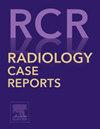A rare case of bilateral rectus sheath hematoma due to anticoagulation: An abdominal CT scan revelation
Q4 Medicine
引用次数: 0
Abstract
Rectus sheath hematoma (RSH) is an uncommon yet clinically significant cause of acute abdominal pain, often overlooked due to its variable presentation and resemblance to other intra-abdominal pathologies. Predisposing factors include anticoagulation therapy, trauma, pregnancy, and strenuous activity, with anticoagulation-associated RSH carrying particularly high morbidity and mortality. We report a case of bilateral RSH in a 68-year-old female with multiple comorbidities, including atrial fibrillation, who was admitted for community-acquired pneumonia. During hospitalization, she developed atrial flutter with rapid ventricular response, necessitating a transition from her home apixaban to therapeutic-dose low molecular weight heparin (LMWH) in anticipation of potential cardioversion or invasive procedures. Later, she experienced sudden-onset severe abdominal pain and distension, accompanied by a marked hemoglobin drop (from 10.2 g/dL to 7.4 g/dL). An emergent abdominal CT scan confirmed bilateral RSH without active extravasation. Given hemodynamic stability, she was managed conservatively with packed red blood cell transfusions, serial hemoglobin monitoring, analgesia, and warm compresses. Her condition improved gradually, with no further bleeding or recurrence of arrhythmia. To our knowledge, this is the second reported case of bilateral RSH linked to LMWH use.
抗凝所致双侧直肌鞘血肿一例:腹部CT显示
直肌鞘血肿(RSH)是一种罕见但临床上重要的急性腹痛病因,由于其表现多样且与其他腹内病变相似,经常被忽视。诱发因素包括抗凝治疗、创伤、妊娠和剧烈运动,抗凝相关RSH的发病率和死亡率特别高。我们报告一例68岁女性双侧RSH合并多种合并症,包括房颤,因社区获得性肺炎入院。在住院期间,她出现心房扑动并伴有快速心室反应,需要从家用阿哌沙班转向治疗剂量的低分子肝素(LMWH),以预测潜在的心律转复或侵入性手术。随后,患者突然出现剧烈腹痛和腹胀,并伴有明显的血红蛋白下降(从10.2 g/dL降至7.4 g/dL)。紧急腹部CT扫描证实双侧RSH无活动性外渗。考虑到血流动力学的稳定性,对患者进行保守治疗,包括充血性红细胞输注、连续血红蛋白监测、镇痛和热敷。患者病情逐渐好转,无出血及心律失常复发。据我们所知,这是第二例与低分子肝素使用有关的双侧RSH报告。
本文章由计算机程序翻译,如有差异,请以英文原文为准。
求助全文
约1分钟内获得全文
求助全文
来源期刊

Radiology Case Reports
Medicine-Radiology, Nuclear Medicine and Imaging
CiteScore
1.10
自引率
0.00%
发文量
1074
审稿时长
30 days
期刊介绍:
The content of this journal is exclusively case reports that feature diagnostic imaging. Categories in which case reports can be placed include the musculoskeletal system, spine, central nervous system, head and neck, cardiovascular, chest, gastrointestinal, genitourinary, multisystem, pediatric, emergency, women''s imaging, oncologic, normal variants, medical devices, foreign bodies, interventional radiology, nuclear medicine, molecular imaging, ultrasonography, imaging artifacts, forensic, anthropological, and medical-legal. Articles must be well-documented and include a review of the appropriate literature.
 求助内容:
求助内容: 应助结果提醒方式:
应助结果提醒方式:


